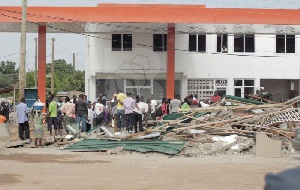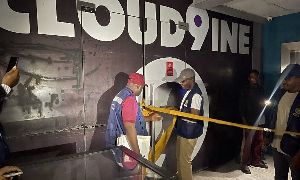Today can report that residents of Borkorborkor near Ablekuma in the Ga West Municipality of the Greater Accra region are sitting on a time bomb, waiting for its last breadth to explode, if authorities do not act quickly.
The imminent danger is in view of the location of a filling station which is across a river way on the Bokorborkor-Manhean-Joma road.
A visit by Today to Borkorborkor showed that the filling station which goes by the name Glee filling station has been built across a natural waterway.
And owing to the fact that the river crosses that part of the road, authorities have built what appears to be a bridge on the road to allow vehicles ply on it.
The paper further gathered that the danger posed by this filling station in the event of explosion will not only be limited to Borkorborkor residents, but to scores of commuters and passengers from Manhean, Oduman, Joma and Afoaman who traverse that stretch of road daily.
It is important to note that close to this filling station is the Prince Legend Preparatory School, a private school, which is well patronised by residents in these said areas.
Investigations by the paper revealed that the Glee filling station which has been operating for the past ten (10) years initially started as a ‘Gao Gao’ filling station (a sub-standard filling station which does not use modern equipment to dispense fuel but rather rely on manual force) later metamorphosed into a proper fuel dispensing station.
Its initial operations, our search revealed, lasted for three years before owners of the facility turned it into a proper fuel dispensing station after obtaining the “necessary permits.”
However, what appears to be the worry of residents in the area is the siting of the filling station across a natural waterway which according to them can explode any time soon.
According to the residents, any time it rained in the area regardless the intensity of the rain, the river known as Borkorbokor, overflowed its bank and flooded the area.
Fearing a recurrence of the fire explosion at Circle Goil filling station on June 3, 2015, the residents suspect some of the overflowed water dripped into the underground fuel tankers.
That situation, they stressed, becomes worst, when there is a heavy downpour.
Incidentally many of the residents and commuters who gave account of their stories on June 3, 2015 to Today indicated that they spent the night right across the river.
Other accounts of the day which has now been christened, “Ghana’s Black Wednesday” showed that cars that dared cross that part of the road were severely damaged.
The residents lamented that they are living in constant fear as the filling station poses serious danger to their lives.
Whilst some could not understand why the filling station had to be sited across a natural waterway, others were of the view that authorities though aware of the danger and profiting from the venture, gave approval.
A resident who has lived in the area for almost twenty five (25) years, Mr. Edward Forson, pointed out that ever since the filling station started operating, residents have been subjected to various health hazards.
Apart from the location of the Glee filling station, Today observed that several buildings (including houses and stores) in the area have been built along with some even on the natural way of the river.
The combination of all these factors, some of the residents contended, contribute to flooding anytime it rained in the area, with some of the water affecting their properties.
And though there is a guideline that regulates the siting of such companies, violation of the regulations by fuel and LPG station owners exposes the public to danger.
Apart from explosions, other identified risks associated with the installation and operation of filling station in residential areas include air pollution, threats to occupational and public health safety, and land degradation.
Consequently, the residents asserted that it is about time the National Petroleum Authority (NPA), Environmental Protection Agency (EPA), and the Ghana National Fire Service (GNFS) acted with a sense of urgency to avert another disaster.
Meanwhile, residents of Santa-Maria Last Stop in Accra have expressed worry over the siting of a Liquefied Gas (LPG) Stations right in the middle of churches, schools and a lorry station.
Some of the residents who spoke to Today on Saturday, June 13, 2015 expressed fear about the loss of lives should there be any gas explosion, since the gas stations are sited close to their houses.
Referring to one of such facilities situated on the shoulders of the Santa-Maria Last Stop Lorry Station, a resident and worker in the area, Kwadwo Asare, said: “I personally cannot tell why anybody would give this gas station permit to operate. It is just too close to us and all of us are at risk should anything go wrong there one day.”
Mr. Asare expressed disquiet about the locations of the gas and fuel stations in the area.
Against this background Santa Maria residents called on the EPA to close down some of the gas and filling stations in the area to avert any major disaster.
According to them, they seemed to be sitting on a time bomb in view of the number of houses close to the gas stations in the area.
The residents said it was dangerous for authorities to allow gas and filling stations to be sited in residential areas, stressing that gas and fuel are inflammable and with any little spark, disaster could strike.
They also appealed to the Ghana Standards Authority (GSA) and the EPA responsible for issuing permits for the construction of gas and filling stations to ensure that they were not sited in residential areas.
It would be called that on Wednesday, June 3, 2015 a Goil filling station which exploded at the Kwame Nkrumah Circle claimed over hundred and fifty lives.
The NPA’s regulations stipulate that gas and fuel stations should be sited at a minimum of 30.8 metres or 100 feet away from residential areas, but the situation on the ground in recent times in Ghana is completely different.
General News of Tuesday, 16 June 2015
Source: Today Newspaper













